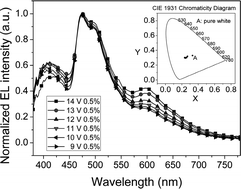Synthesis and optoelectronic properties of a heterobimetallic Pt(ii)–Ir(iii) complex used as a single-component emitter in white PLEDs†
Abstract
To tune aggregation/excimer emission and obtain a single active emitter for white

* Corresponding authors
a
College of Chemistry, Key Lab of Environment-Friendly Chemistry and Application in Ministry of Education, Xiangtan University, Xiangtan, China
E-mail:
zhuwg18@126.com, qij8304@hotmail.com
Fax: +86 731 58292251
Tel: +86 731 58298280
To tune aggregation/excimer emission and obtain a single active emitter for white

 Please wait while we load your content...
Something went wrong. Try again?
Please wait while we load your content...
Something went wrong. Try again?
X. Li, Y. Liu, J. Luo, Z. Zhang, D. Shi, Q. Chen, Y. Wang, J. He, J. Li, G. Lei and W. Zhu, Dalton Trans., 2012, 41, 2972 DOI: 10.1039/C2DT12027E
To request permission to reproduce material from this article, please go to the Copyright Clearance Center request page.
If you are an author contributing to an RSC publication, you do not need to request permission provided correct acknowledgement is given.
If you are the author of this article, you do not need to request permission to reproduce figures and diagrams provided correct acknowledgement is given. If you want to reproduce the whole article in a third-party publication (excluding your thesis/dissertation for which permission is not required) please go to the Copyright Clearance Center request page.
Read more about how to correctly acknowledge RSC content.
 Fetching data from CrossRef.
Fetching data from CrossRef.
This may take some time to load.
Loading related content
